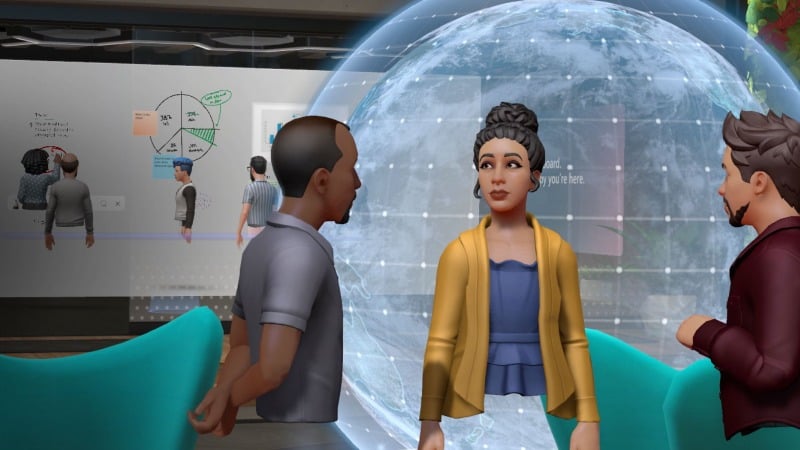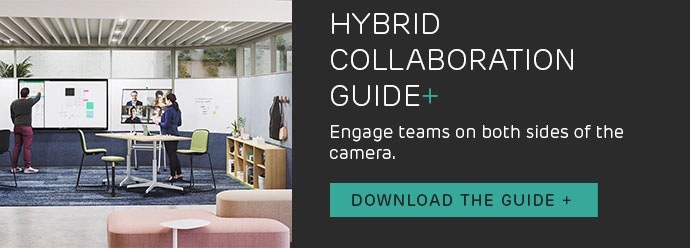For the last couple of years, discussion around the future of work has focused on how many employees will return to the physical office. Now, as companies across the globe settle into a hybrid work model, the debate has turned to how new technologies could offer an exciting way to improve the hybrid experience.
Enter the metaverse workplace.
What is a metaverse workplace?
A metaverse workplace is a virtual reality environment that replicates the experience of being in an office, but allows people to work from anywhere in the world.
.jpg?width=800&height=450&name=My%20project-1%20(55).jpg)
Mark Zuckerberg, CEO of Meta, predicts we're no more than five years away from working in the metaverse.
82% of US business leaders expect metaverse plans to be part of their business activities within three years, according to a report by PwC.
And a study in the UK suggests that half of all organisations are exploring the possibility of bringing the office to workers' living rooms as they respond to the demand for hybrid working.
Writing for Harvard Business Review, Mark Purdy paints a picture of what this might look like:
"Imagine a world where you could have a beachside conversation with your colleagues, take meeting notes while floating around a space station, or teleport from your office in London to New York, all without taking a step outside your front door. Feeling under pressure with too many meetings scheduled today? Then why not send your AI-enabled digital twin instead to take the load off your shoulders?"
Many experts see the metaverse as a 3D model of the internet, a place parallel to the physical world, where you spend your digital life as an avatar and interact with others and their avatars. But the ultimate metaverse, a single location people can go to live their virtual life, doesn't yet exist.
At a basic level, the metaverse is a series of digital worlds accessed through VR headsets. Several tech companies, from industry leaders to start-ups, have already started experimenting with VR work environments:
-
Meta has created Horizon Rooms, a VR space for team meetings
-
Cisco launched the Webex Hologram, an augmented reality tool for team meetings
-
Microsoft has developed Mesh for Microsoft Teams which allows colleagues to collaborate in immersive VR spaces
-
UK-based start-up PixelMax has created an immersive workplace focused on improving wellbeing and collaboration
-
Indian company NextMeet has launched an avatar-based platform that supports interactive working and L&D.
What are the potential benefits of a metaverse workplace?
A metaverse workplace could offer myriad benefits to both employers and employees, from better training opportunities and collaboration to more choice and flexibility. Most of its potential merit lies in enhancing the work-from-home experience in a hybrid working model.
Accelerated skills development
In research by PwC, onboarding and training topped the ways in which businesses plan to interact with the metaverse.
As Mark Purdy says:
"The metaverse could revolutionise training and skills development, drastically compressing the time needed to develop and acquire new skills."
This doesn't seem such a stretch, given VR technology is already being used in several industries to accelerate skills development. For example, surgical tech company Medivis has been using the technology to train students through highly-interactive 3D anatomy models in the healthcare industry. Meanwhile, Metaverse Learning has created augmented reality training models for frontline nurses in the UK.
Enhanced collaboration
Imagine hybrid meetings where all colleagues can step into one space as avatars, with all the benefits of communication and authentic connection that face-to-face interaction brings. Meta's Horizon Workrooms and Microsoft Mesh are already making this possible.

Image source: Microsoft Mesh
The metaverse could even make collaboration better than in the real world. Think no boundaries on collaboration tools and the ability to transport the whole team to another location - or another world - for inspiration.
Using a metaspace at work could also allow employees to recreate their in-office experience online, as avatars move around and interact with others just as they would in the physical space. The opportunities for spontaneous interactions that are missing with remote work could be remedied by the metaverse, leading to more innovation.
But does all this really beat real-life, in-person interactions with everyone sharing the same physical space, where you have access to all the tools you need and a supportive and inspiring environment to move the dial? The metaverse can improve hybrid collaboration but can't replace in-person collaboration.
Improved wellbeing
In the office, wellness rooms provide an excellent place for workers to take a break, relax, recharge and take care of their mental health. But what about when working from home? Imagine working in the metaverse and taking a dip in the ocean, relaxing in a beach deck chair, or even taking a walk on the moon.
Some employees find it difficult to switch off at the end of the day when working from home. The metaverse could help them feel more of a separation between home and work, as stepping into the metaverse at the start of the day and leaving once work is done mimics the same experience they have in the physical office.
But, could spending too much time in the metaverse have a detrimental effect on workers' health? Working in the metaverse would have more benefits when working from home, but it would need to be balanced out with time in the physical office.
A more inclusive environment
Hybrid working has given workers benefits such as increased flexibility, but drawbacks include feelings of loneliness and disconnection from the team. Working in the metaverse while at home could help combat some of those feelings by providing a more social environment and facilitating more engaging and energised interactions. And a virtual place to go that is on-brand could help people feel a greater sense of belonging to a company.
More control
Employees like choice and control over the working environment. The environment could be tailored to the individual's personal preferences in the metaverse. For example, one colleague could see the walls in green, while another could choose to see them in yellow. The metaverse blows away any limitations on how workers can shape and refine the space around them.
Is it all a step too far?
The metaverse has the potential to benefit employees and employers alike as long as it focuses on enhancing hybrid work rather than replacing the physical office altogether.
As Strauss Zelnick, CEO of gaming development company Take-Two, said in a recent interview, we don't want to end up in a world where everyone works in the metaverse all of the time:
"I'm skeptical that we're going to wake up in the morning and intentionally sit at home, strap on our headsets and conduct all of our daily activities that way. We had to do that during the pandemic, and we don't really like it so much."
Summary
Today's workplace has evolved more than we could have imagined just a couple of years ago. The rise of hybrid working has changed expectations around where and how people work. But change doesn't end here. The workplace is constantly evolving.
We don't know exactly what a metaverse workplace will look like just yet, but it has the potential to enhance the hybrid work experience. We'll have to see if, as Mark Zuckerberg predicts, we'll be walking around the virtual office and interacting with colleagues as avatars in just a few years.










